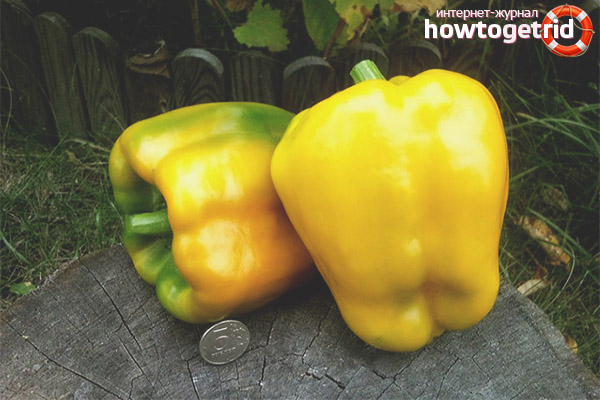The content of the article
A medium-sized variety with thick-walled fruits, harvesting can be done 110 days after planting in open ground. Ideal for greenhouse conditions and growth on sandy soils. The variety has high palatability, which owes its popularity, has an impressive shelf life.
Grade description
Pepper is resistant to transportation over long distances. The variety is suitable for both growing in greenhouse conditions and in open ground. Fruits can be consumed fresh, used for preservation and stuffing.
Growing
Growing seedlings should begin with the selection of seeds. Pour them with a glass of water, those that come up can be considered a marriage. Then let them dry and perform a hardening procedure. To do this, place the seeds in a non-concentrated solution of potassium permanganate, this will help in the future to avoid the appearance of fungal diseases.
- After fifteen minutes, remove the seeds and place them on wet cheesecloth and let them swell well.
- Plant seeds in peat pots. It is very important not to use large pots, as the pepper root system develops rather slowly.
- It is recommended to start growing seedlings 65 days before the expected moment of planting in open ground.
- Most novice gardeners often make the same mistake. They start growing seedlings too early when daylight hours are still short. At the same time, they do not provide additional lighting for seedlings. Plants turn out to be lethargic and weak.
- When planting in open ground, it is worth considering the fact that the pepper will feel extremely uncomfortable in windy places. For this crop, greenhouse conditions would be preferable. It is worth planting seedlings so that no more than three plants are located on one square meter, because pepper has a rather powerful root system.
With proper care and proper agricultural technology, from one bush you can collect up to four kilograms of product.
Care
An important component of care is watering. Pepper does not like drought, but also does not tolerate excess water. Therefore, it is necessary to ensure that the soil does not dry out, but do not overdo it, otherwise there is a risk of fungal diseases.
Watering is carried out directly under the root, as otherwise there is a risk of sunburn.
For irrigation, it is advisable to use warm, settled water with a small addition of wood ash.
Do not also forget about removing stepchildren. Pasynkovka helps to direct all the energy of the plant to the development of the fruit, not the bush. Despite all its benefits, doing this event more than once a week is not worth it.
The variety prefers rich soils, otherwise it will need regular fertilizing with complex and organic fertilizers.
Especially for this purpose, you can make an herbal solution. Pour a large amount of freshly cut grass into the barrel and pour a large amount of warm water, after which leave the whole thing alone for at least two weeks. After the time, strain the tincture. Watering with this product is carried out no more than three times a week.
Advantages and disadvantages
The advantages of this culture include:
- Resistant to most diseases and pests.
- High palatability.
- Long shelf life.
- Resistance to transportation over long distances.
The only drawbacks are the exactingness to the soil on which the Tolstopuz cultivar grows.
Video: how to form pepper










Submit